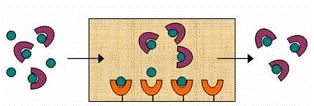Department of Chemistry
Document Type
Article
Date of this Version
2-1-2010
Citation
Published in final edited form as: Anal Biochem. 2010 February 1; 397(1): 107–114. doi:10.1016/j.ab.2009.10.017. Version presented here is from NIH PubMed Central
Abstract
Columns containing immobilized lipoproteins were prepared for the analysis of drug interactions with these particles by high-performance affinity chromatography. This approach was evaluated by using it to examine the binding of high density lipoprotein (HDL) to the drugs propranolol or verapamil. HDL was immobilized by the Schiff base method onto silica and gave HPLC columns with reproducible binding to propranolol over four to five days of continuous operation at pH 7.4. Frontal analysis experiments indicated that two types of interactions were occurring between R/S-propranolol and HDL at 37°C: saturable binding with an association equilibrium constant (Ka) of 1.1–1.9 × 105 M−1, and non-saturable binding with an overall affinity constant (n Ka) of 3.7–4.1 × 104 M−1. Similar results were found at 4 and 27°C. Verapamil also gave similar behavior, with a Ka of 6.0 × 104 M−1 at 37°C for the saturable sites and a n Ka value for the non-saturable sites of 2.5 × 104 M−1. These measured affinities gave good agreement with solution-phase values. The results indicated HPAC can be used to study drug interactions with HDL, providing information that should be valuable in obtaining a better description of how drugs are transported within the body.


Comments
Copyright Elsevier Inc. Used by permission